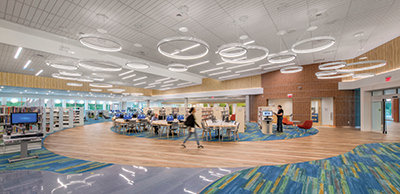
As learning becomes more fluid, personal, and technology-driven, the role of the library is rapidly shifting. I believe the library of the future is not just a resource center—it’s a classroom in its own right: a space for lifelong, interest-driven, and community-powered learning.
Several of the readings support this idea. Mathews (2013) and Stephens (2014, 2016) reimagine librarians as facilitators of infinite learning, designing experiences far beyond traditional reference help. This redefinition includes everything from “messy learning” (Block, 2014) to “learning everywhere” (Stephens, 2012), where curiosity, experimentation, and play take center stage.
Libraries are embracing this role through programs that blend creativity and technology. Makerspaces and 3D printing labs, like those at White Plains Public Library and Chicago Public Library (Digital Promise, 2016), empower patrons to build, create, and learn through doing—offering classroom-like experiences without the constraints of a formal curriculum. Doctorow (2013) calls this a “match made in heaven,” where access meets innovation.
John Palfrey’s “BiblioTech” (2015) reinforces what the evidence increasingly shows: as educational boundaries blur, libraries become essential hubs for lifelong learning—places where education extends beyond institutional walls into community spaces.
The library’s role as a community classroom also emphasizes inclusivity and access. Lauersen (2020) advocates for library strategies centered on culture, diversity, and shared learning, while initiatives like sensory spaces (Public Libraries Connect, 2018; Marsden Library, 2018) create environments that are welcoming for all learning styles.
In today’s digital world, spaces like Fountaindale’s Studio 300 or DC Public Library’s Memory Lab show how libraries help bridge digital divides and cultivate 21st-century skills. Pew Research (2016) confirms that tech-access leads to more lifelong learning—and libraries are key to making that access equitable.
The future library is about so much more than books or even information—it’s about transformation through learning. As society’s educational needs evolve, libraries are positioning themselves not alongside classrooms, but as classrooms themselves: flexible, inclusive, and built for the future of learning.
References
Block, J. (2014). Embracing messy learning. Retrieved from https://www.libraryjournal.com/?detailStory=embracing-messy-learning
Digital Promise. (2016, January 28). Chicago Public Library: The library as a gateway to 21st-century skills. Retrieved from https://digitalpromise.org/2016/01/28/chicago-public-library-the-library-as-a-gateway-to-21st-century-skills/
Doctorow, C. (2013). Libraries and makerspaces: A match made in heaven. Retrieved from https://boingboing.net/2013/03/27/libraries-and-makerspaces-a-m.html
Lauersen, C. (2020). Learning, culture, community and diversity: New library strategy for Roskilde Libraries 2020. Retrieved from https://www.r-b.dk/om-os/strategi/
Mathews, B. (2013). Curating learning experiences: A future role for librarians? Retrieved from https://www.libraryjournal.com/?detailStory=curating-learning-experiences-a-future-role-for-librarians
Palfrey, J. (2015). BiblioTech: Why libraries matter more than ever in the age of Google. Basic Books.
Public Libraries Connect. (2018). SL Blogs – Sensory Spaces. Retrieved from https://publiclibrariesconnect.org/2018/04/11/sl-blogs-sensory-spaces/
Pew Internet & American Life Project. (2016, March 22). Lifelong learning and technology. Retrieved from https://www.pewresearch.org/internet/2016/03/22/lifelong-learning-and-technology/
Stephens, M. (2012). Learning everywhere. In The heart of librarianship: Attentive, positive, and purposeful change (p. 123). Chicago, IL: ALA Editions.
Stephens, M. (2014). YLibrary: Infinite learning. Retrieved from https://stephenslighthouse.com/2014/01/01/ylibrary-infinite-learning/
Stephens, M. (2016). LibraryEmoji [PDF]. Retrieved from https://stephenslighthouse.com/2016/01/01/libraryemoji/
White Plains Public Library Teens. (2015). Hour of Code. Retrieved from https://www.whiteplainslibrary.org/2015/12/hour-of-code/
White Plains Public Library Teens. (2016). What is 3D Printing? Retrieved from https://www.whiteplainslibrary.org/2016/04/what-is-3d-printing/
Marsden Library. (2018). Sensory Space at Marsden Library. Retrieved from https://www.marsdenlibrary.org/sensory-space
Hi Angela, great job on your post! I’m sure you have read in the reading, but an awesome way some libraries are supporting lifeline learning among patrons is the use of makerspaces. Essentially they are spaces where library patrons can learn and create physical materials using resources like computers, 3-D printers, and audiovisual capture tools. I was inspired to research if makerspaces were offered in my public library, and I was happy to see that they available in some library locations. I definitely recommend to see if you one in your own public library and check it out.
Thank you Daniel! I agree and feel they are vital in many ways (sad to see such things are less and less available in schools or other venues). We are working to create one in our small public library. Space is definitely an issue, but luckily our community is very supportive and we have a strong Friends and Foundation to support is fiscally.